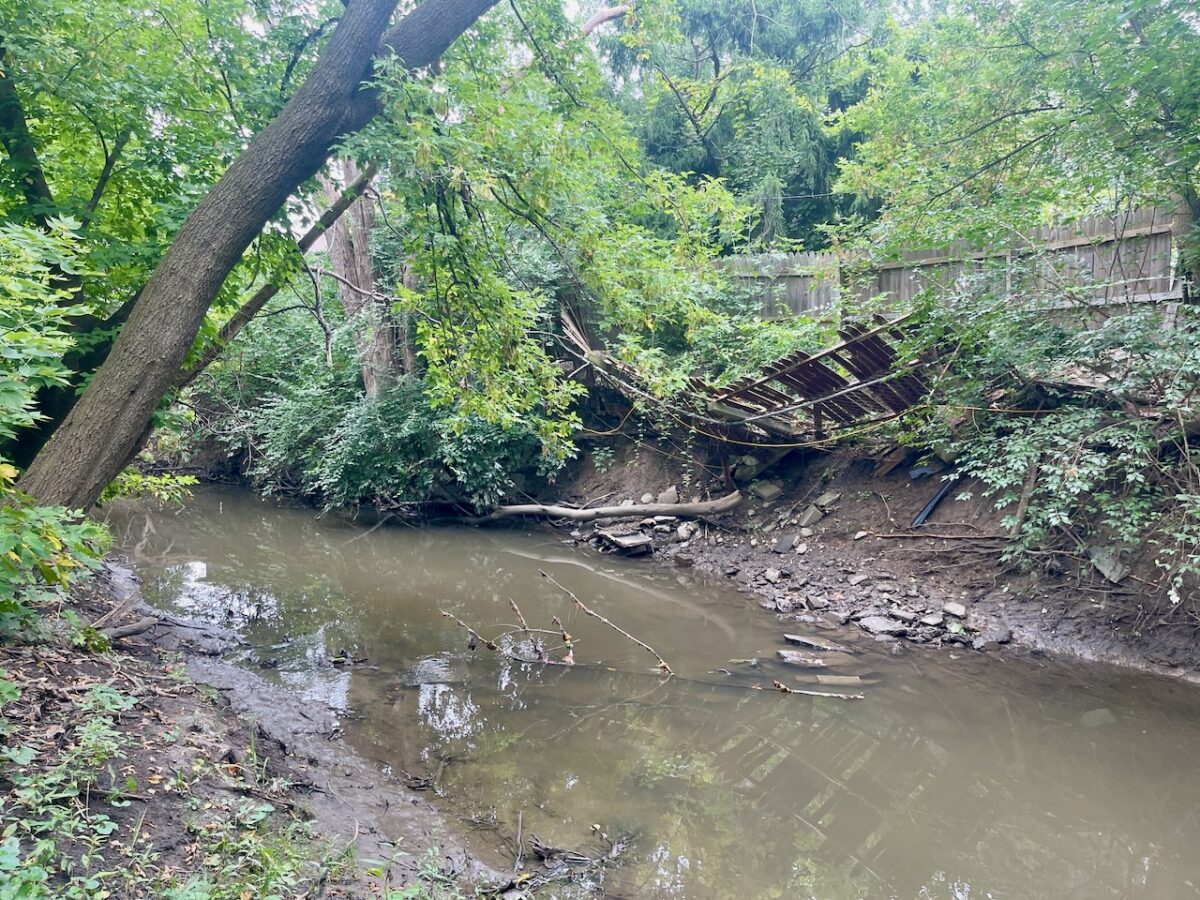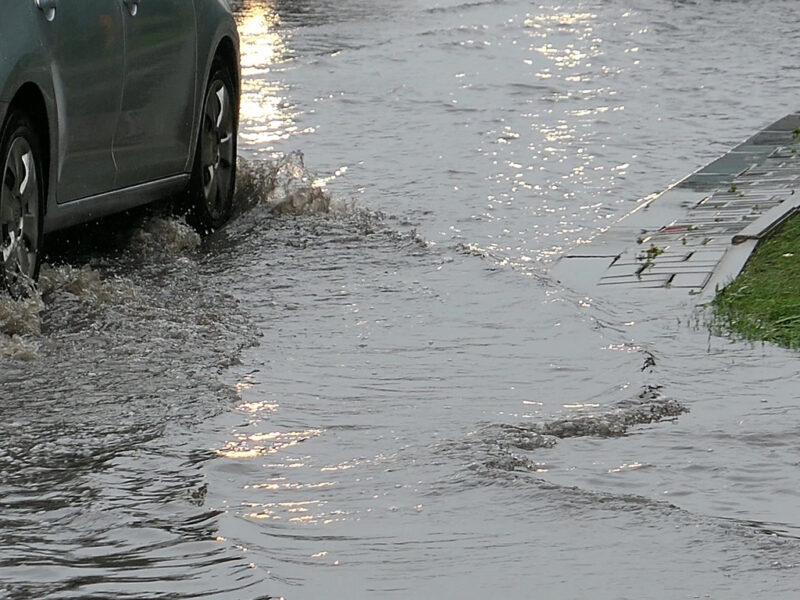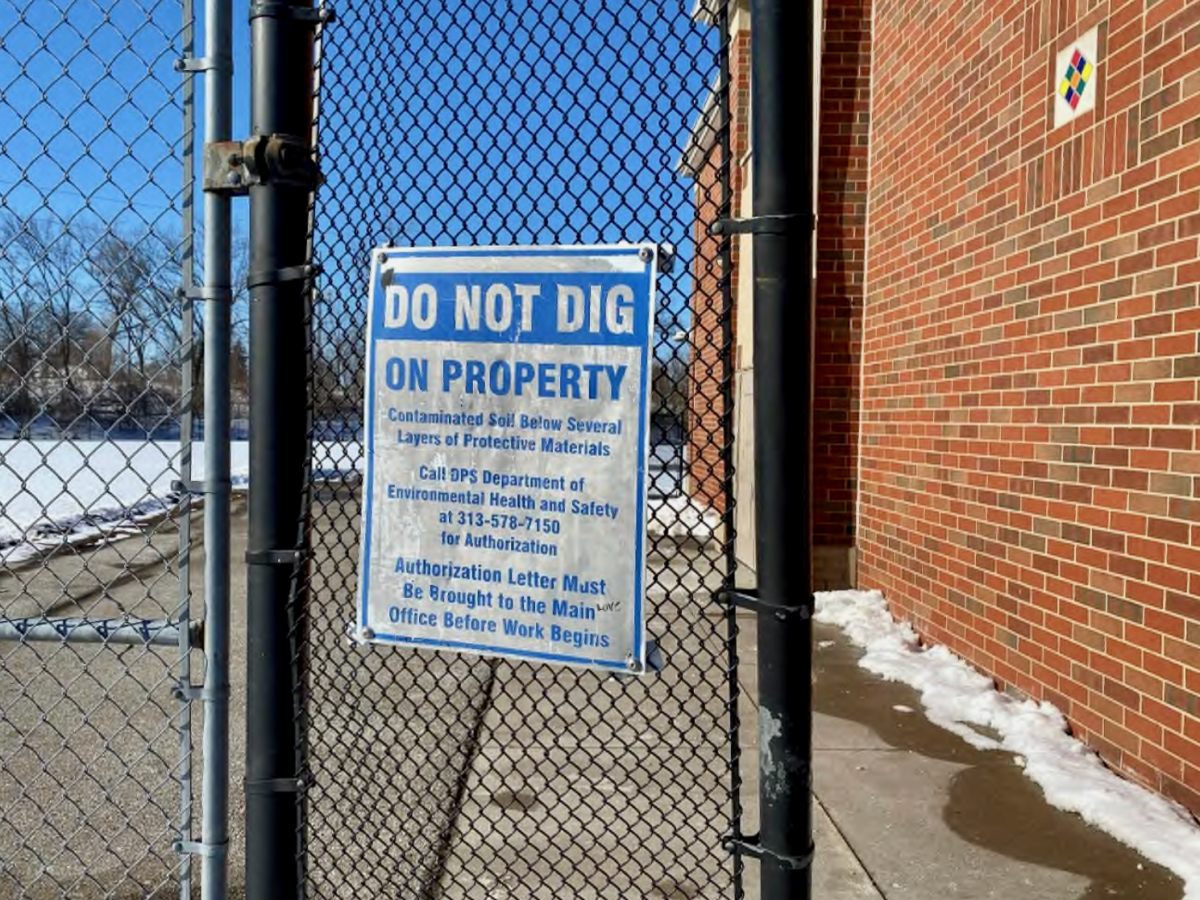Overview:
-Dearborn Heights is advocating for additional FEMA funds to buy flood-prone homes and manage Ecorse Creek.
-Climate change is intensifying these issues with heavier rainstorms.
-"You're slowly watching people's backyards just disappear," a resident tells Planet Detroit.
After water from Ecorse Creek flooded his home in 2019, Dearborn Heights resident Randy Lopez worries whenever there’s a major storm.
“Every time you hear a heavy rain coming, it creates anxiety,” he said.
The heavy rainfall that flooded streets and basements on April 2 spared Lopez’s home on Currier Street, although the Ecorse Creek runs behind his house. But the event is a reminder of the precarious situation faced by residents who live in the Federal Emergency Management Agency designated flood zone in Dearborn Heights, which covers several blocks near the junction of Telegraph and Van Born roads.
Flooding has centered on Currier and Hanover streets, on opposite sides of the creek. Lopez said he had nine inches of water in his basement in 2021, but others had feet.
Three to four homes reported flooding on April 3, although far more were likely affected, Dearborn Heights Mayor Bill Bazzi told The Detroit News.
FEMA spent $3.18 million to purchase 18 flood-prone homes along the Ecorse Creek in 2024, converting them to green space with deed restrictions to prevent future development.
Bazzi told Fox 2 the city is seeking more money from FEMA to purchase homes.
“They shouldn’t have built homes here in the ’60s, but they did, and now we have to fix it,” Bazzi said.
Lopez said the money he was offered for his home wasn’t enough to convince him to sell because high housing prices and interest rates could make finding a new home difficult.
Climate change adds to metro Detroit flooding threat
Conservation organizations, municipalities, and government agencies are looking to manage flooding by removing sediment and debris from the creek and creating more detention areas to temporarily sequester runoff that flows from the heavily developed watershed. Climate change is bringing heavier rainstorms, adding to longstanding flooding issues.
“It’s multiple issues compounding together that are giving us this flooding, and Dearborn Heights specifically takes the brunt of it,” said McKenzi Waliczek, stewardship director for Friends of the Detroit River.
On April 2, the Detroit area received 2.18 inches of rain in 24 hours, or roughly two-thirds the amount of precipitation the area usually receives for the entire month of April, according to National Weather Service data.
Human-caused climate change is leading to heavier rains and increasing flood risks in most U.S. cities because warmer air can hold more moisture, according to research from the nonprofit climate science organization Climate Central. In Detroit, rainfall intensity increased 25% between 1970 and 2024.
These increasingly heavy storms have contributed to flood events like the billion-dollar disasters that hit metro Detroit in 2014 and 2021. In the Ecorse Creek watershed, the U.S. Army Corps of Engineers estimates the average annual flood damages total $22 million.
MORE FLOODING COVERAGE
Flooding possible in Detroit, GLWA issues alert
Metro Detroit faces a flood watch until 8 a.m. Thursday, with 1.5 to 2 inches of rain expected.
Southwest Detroit school built atop contaminated site not impacted by nearby flood, officials say
Roberto Clemente elementary school sits across the street from homes that were flooded on Feb. 17. The site is capped to prevent exposure to chemicals left over from a legacy of industrial use.
GLWA’s $138 million flood prevention project sparks outrage in Jefferson Chalmers
The project aims to make regional water infrastructure more resilient and help with flood prevention. However, residents are troubled by the city of Detroit and Great Lakes Water Authority’s slow outreach.
Officials, conservation groups seek flooding solution
Over a century of straightening the Ecorse Creek to make way for agriculture and the subsequent paving of a majority of the watershed has contributed to flooding problems in the area, according to Waliczek.
The North Branch of the Ecorse Creek, which runs through Westland, Romulus, Dearborn Heights, Allen Park, Melvindale, and Lincoln Park, is highly developed, and over 90% of the watershed for all branches of the creek is covered by impervious surfaces, according to a report from Friends of the Detroit River.
“We’re at this point where there’s just nowhere else for the rain to go,” Waliczek said.
Buildings, paved surfaces, and heavy clay soils can all prevent water from penetrating the ground and send it into the creek during heavy rains, Waliczek said.
The Ecorse Creek Watershed Management Plan, put together by Friends of the Detroit River and the Alliance of Downriver Watersheds, a group of 23 public agencies, has identified 85 priority sites for project locations in the watershed where ecological restoration activities could be used to sequester stormwater and allow water to more gradually enter the waterway.
Waliczek said the number of potential sites was narrowed down to 11 that are considered to be the most impactful, and FDR is leading efforts to secure grant money for projects in these areas.
The U.S. Army Corps of Engineers is also working on plans for a retention/detention basin at Inkster Road and Powers Avenue to regulate the flow of stormwater into the creek, Dearborn Heights Mayor Bill Bazzi told Channel 4 last year.
And the city of Dearborn Heights announced in August a collaboration with the Downriver Community Conference and other groups to develop a design for restoring a 1-mile portion of the North Branch of the Ecorse Creek, including flood control measures, habitat restoration, and opportunities for public access to the creek.
The city of Dearborn Heights did not respond to questions about the status of the project, which was receiving funding from the Bipartisan Infrastructure Law.
In a statement on Facebook, Mayor Bazzi said the region’s flooding is a “a multi-city and multi-faceted problem,” adding that he is committed to advocating for “a long overdue permanent solution to the flooding which has plagued our city for decades.”
Maintenance projects look to clear debris from the creek, remove trees
The U.S. Army Corps of Engineers estimated that addressing flooding issues on the North Branch of the Ecorse Creek could cost $500 million, WXYZ reported. Instead of waiting on this level of funding, Wayne County has invested $10 million in maintenance for the creek, removing sediment and logjams that could contribute to flooding as well as stabilizing creekbanks.
The county also began removing some trees along the stream to prevent future obstructions. The move has prompted some pushback from residents, and Waliczek said these trees can help stabilize creek banks and provide wildlife habitat.
Lopez, on Currier Street, said the erosion of creek banks is one of his biggest concerns.
“You’re slowly watching people’s backyards just disappear,” he said, expressing concern about erosion in his own yard.
In other respects, Lopez said he continues to appreciate having the creek in his backyard, despite the stress it has caused. He said he regularly sees possums, raccoons, and rabbits along the creek as well as waterbirds like ducks and herons.
“There’s certain virtues that goes with having a creek back there,” he said.





